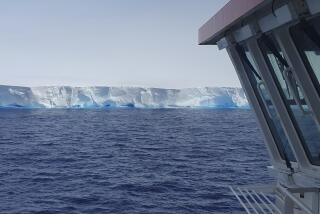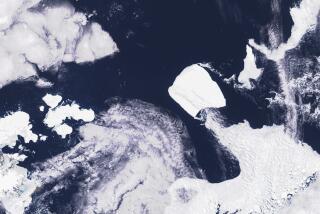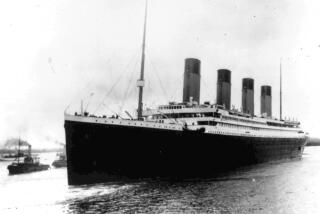In These Chill Waters, Icebergs Are the Catch
OFF NEWFOUNDLAND — The icebergs may be big, but the ocean is endless.
The hours pass as Tristan Krein stares out the window of the Hercules C-130, searching for ice. Sometimes he takes out his binoculars and scans the empty horizon; other times, clouds obscure the waves and he is a man looking at nothing.
“Sometimes we’re begging for things to look at,” says Krein, 35.
But other times, the members of the International Ice Patrol look down and see peaks of glistening white floating in the frigid currents. They record the iceberg’s location, its size and its shape, and they know that every observation they make is crucial.
Every other week during the iceberg season--usually from February to July--the Ice Patrol flies over the North Atlantic, keeping track especially of the southernmost area in which icebergs have been spotted. This is crucial; the patrol’s findings tell mariners how far south they must sail to avoid any chance of hitting an iceberg.
These, after all, are the waters that claimed the Titanic.
In fact, the Ice Patrol, operated by the U.S. Coast Guard on behalf of 17 countries, has been looking for icebergs since 1913, after a horrified world resolved that it would never again allow the kind of accident that sent the Titanic to the Atlantic floor on April 15, 1912.
In all those years, there has not been a single reported loss of life or property from a collision with an iceberg in an area the Ice Patrol proclaimed to be safe.
“It’s incredibly important,” says the patrol’s commander, Bob Desh.
It’s also obscure. There have been books written about the patrol--in fact, Krein recalls reading one when he was in school--but mostly, it does its work quietly.
Krein did not join the Ice Patrol because of that book (by the time he had enlisted, he’d even forgotten that the patrol was part of the Coast Guard). He, like his fellow “ice picks,” joined the patrol because it’s a small unit with a unique mission.
“It was different from everything else,” says Bryan Grebe, 26. Like the others, he is a marine science technician. Chances are, if he weren’t a member of the Ice Patrol he would be inspecting vessels to ensure that they are safe.
Instead, they supervise as temperature and current sensors are dropped from the plane. They stare out the windows, or they watch over the shoulders of technicians--”tweets”--who monitor forward- and side-looking radar.
And at the end of a day aloft, they examine their data and send them to patrol headquarters in Groton, Conn. There, the information is plugged into computer models that will project the drift of the icebergs; twice a day, the patrol issues reports that are dispatched to the nations that share the $11,000-an-hour cost of the patrol’s flights.
The icebergs calve from Greenland’s glaciers, the result of thousands of years of accumulated snow. After melting slowly in cold Arctic bays, they are carried south to the Grand Banks by the Labrador Current. Four hundred to 800 a year make it as far as the 48th parallel, which is even with St. John’s, Newfoundland. Eventually, they melt in warmer waters.
The smallest ones are known as growlers because they make a growling noise as they rise and fall with the swells. The section above water--the smallest part--is less than 3 feet high and 16 feet long.
The largest iceberg ever seen in the North Atlantic was 550 feet tall, nearly as tall as the Washington monument. But most are small or medium-sized, like the one that destroyed the Titanic: 50 to 100 feet high and 200 to 400 feet long.
Most of the time, the ice picks fly at 6,500 feet, and the icebergs appear to be “a thumbnail on the horizon,” Desh says. About 70% of the time, he says, they don’t see the icebergs at all; they’re obscured by clouds or fog, and are observed only by radar.
So this is the Ice Patrol’s glamorous duty: six to eight hours in a cold, noisy (earplugs required), 29-year-old tin can of an airplane, with the likelihood of seeing nothing.
Sometimes a crew member sets up a hammock at the rear of the plane and sacks out.
Climb up on the flight deck and you’ll find flight engineer Chris Collins paging through a book filled with compact discs: Veruca Salt, George Thorogood, Rush, Shania Twain. He pops one into a CD player connected to the intercom system. “That’s our flight entertainment,” he says.
Pilot Carey Hixson and co-pilot Wes Hester often have their feet up. The plane must fly precise routes so that its radar will map the seas precisely, and autopilot does that.
“Takeoff and landing--otherwise it’s boring,” says Hixson.
So why do they do it?
Partly, it’s the extra pay--a $70 per diem while they’re in Newfoundland, and $150 a month in flight pay. Partly, it’s because they like coming up from Groton and Elizabeth City, N.C., where the tweets, the flight crews and the mechanics are based.
There are local delicacies, like moose steak and codfish tongues. And Krein says he and others have had girlfriends in Newfoundland. “They’re very friendly up here--and I mean that in a very respectful way,” he says, hastening to add that he is true to his current girlfriend back in Connecticut.
But mostly they do it because they believe they are accomplishing something important.
They know what happens when ice meets metal. Every year, they mark the anniversary of the Titanic’s sinking with a ceremony outlined in the Coast Guard’s manual of standard operating procedure.
On this year’s 90th anniversary, on April 15, the C-130 dipped to 400 feet, affording the crew a remarkable view of two icebergs, one of them about the size of the one the Titanic hit. “It is with great respect and reverence,” Hixson said, that the Coast Guard remembered the 1,522 victims of the Titanic and paused “to remember the importance of our mission.”
And then crew members dropped two bouquets from the open cargo door.
“It puts a lump in my throat,” says Jim Wineteer, 32, one of the tweets.
Wineteer has given a lot of thought to the Titanic disaster. Those 1,522 people weren’t really killed by the iceberg, he says; they were killed by the arrogance of the engineers and the technicians who did not believe in their own fallibility or the power of nature.
It is a mistake, he says, that the International Ice Patrol will not make.
More to Read
Sign up for The Wild
We’ll help you find the best places to hike, bike and run, as well as the perfect silent spots for meditation and yoga.
You may occasionally receive promotional content from the Los Angeles Times.






